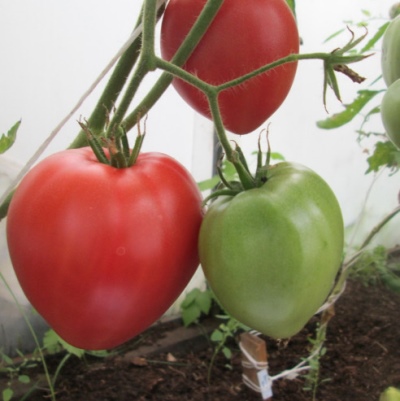
- Authors: Kentucky, USA
- Name synonyms: African Vining, African Viking, African Viking
- Category: grade
- Growth type: indeterminate
- Appointment: fresh consumption, for juice
- Ripening period: mid-season
- Growing conditions: for closed ground
- Bush size: tall
- Bush height, cm: 150-200
- Ripe fruit color: rich raspberry
There are varieties of tomatoes that grow wonderfully indoors. Among them, the African Liana variety stands out with rich crimson fruits.
Breeding history
The varieties were bred in the state of Kentucky. This plant is also called the African Viking.
Description of the variety
If we talk about the type of growth, then this variety is classified as indeterminate. Bushes are tall, usually 1.5 to 2 meters high.
The foliage is ordinary, thin. You cannot do without tying the plant to the trellis. It is imperative to carry out pinching of bushes at a certain stage of vegetative growth. You can achieve maximum yield if you form the African liana in two stems.
The main qualities of the fruit
Tomatoes of this variety grow from 400 to 500 grams. They are beautiful in shape, heart-shaped. They are used not only fresh to the table, but also for the production of juice. One hand has 2 to 4 fruits.
Taste characteristics
Under the skin of this tomato variety, there is a dense pulp with a harmonious, balanced and sweet taste. For such qualities, the African liana is appreciated.
Ripening and fruiting
Mid-season variety, fruiting until frost.
Yield
The African liana gives a large harvest.
The timing of planting seedlings and planting in the ground
Since the variety is planted indoors, the time to plant the seeds depends on when the grower wants to get fruit. After 65-70 days, the seedlings can be planted in the greenhouse.

Growing tomato seedlings is an extremely important process, because it largely depends on whether the gardener will be able to harvest at all. All aspects must be taken into account, from seedbed preparation to planting in the ground.
Landing scheme
Planting should be done in such a way that there is enough space between the plants for development. It is important to take into account the fact that the bushes are tall, therefore it is necessary to ensure good ventilation between them.

Growing and care
Soil for tomato African liana should be rich in organic matter. The addition of compost may be sufficient for a good harvest. In the long term, it is better to use organic fertilizers such as animal dung or composted leaves, because overuse of inorganic chemical fertilizers can harm the soil.
If it is not possible to use organic matter, then it is better to apply nitrogen-phosphorus-potassium (5-10-5) fertilizer, also called plant fertilizer.Pre-fertilize the soil before planting African Vines, and then start a regular feeding program once or twice a month after the first fruits appear.
However, be careful when using tomato fertilizers, too much nitrogen can result in beautiful green foliage but little fruit.
The best soil for African liana is crumbly sandy loam, rich in organic matter, with good drainage.
Watering plays an important role in the growing process of any tomato variety. With a lack or excess of moisture, two common problems arise - cracking of the skin and rot at the end of the flower. In this case, water the base of the plant, not the leaves, use drip irrigation with a timer. The soil should not be allowed to dry completely, but you should try to maintain constant moisture.
Timely pruning is also indispensable. It reduces the likelihood of many diseases occurring. First of all, the lower leaves, which are as close to the ground as possible, are removed, since they are the first to begin to hurt. All the appeared stepsons also need to be removed. The less dense the bush, the faster the leaves dry out, respectively, there is no favorable environment for pathogenic microorganisms.




A plant needs different micronutrients at each stage of growth. All fertilizers can be divided into two groups: mineral and organic. Folk remedies are often used: iodine, yeast, bird droppings, eggshells.
It is important to observe the rate and period of feeding. This also applies to folk remedies and organic fertilizers.
Disease and pest resistance
It is necessary to begin to fight against pests and diseases before they appear. Insecticides and fungicides to help the grower.
Neem oil, soap solution, infusion of garlic help well against aphids, bedbugs and other insects.
There are diseases that cannot be cured with insecticides. Only preventive measures help in this case. First of all, this is timely weeding, removal of foliage, control of the level of moisture and the amount of light received by the plant.


Growing regions
When planted in a greenhouse, you can get a decent harvest in any region of the country.

























































































